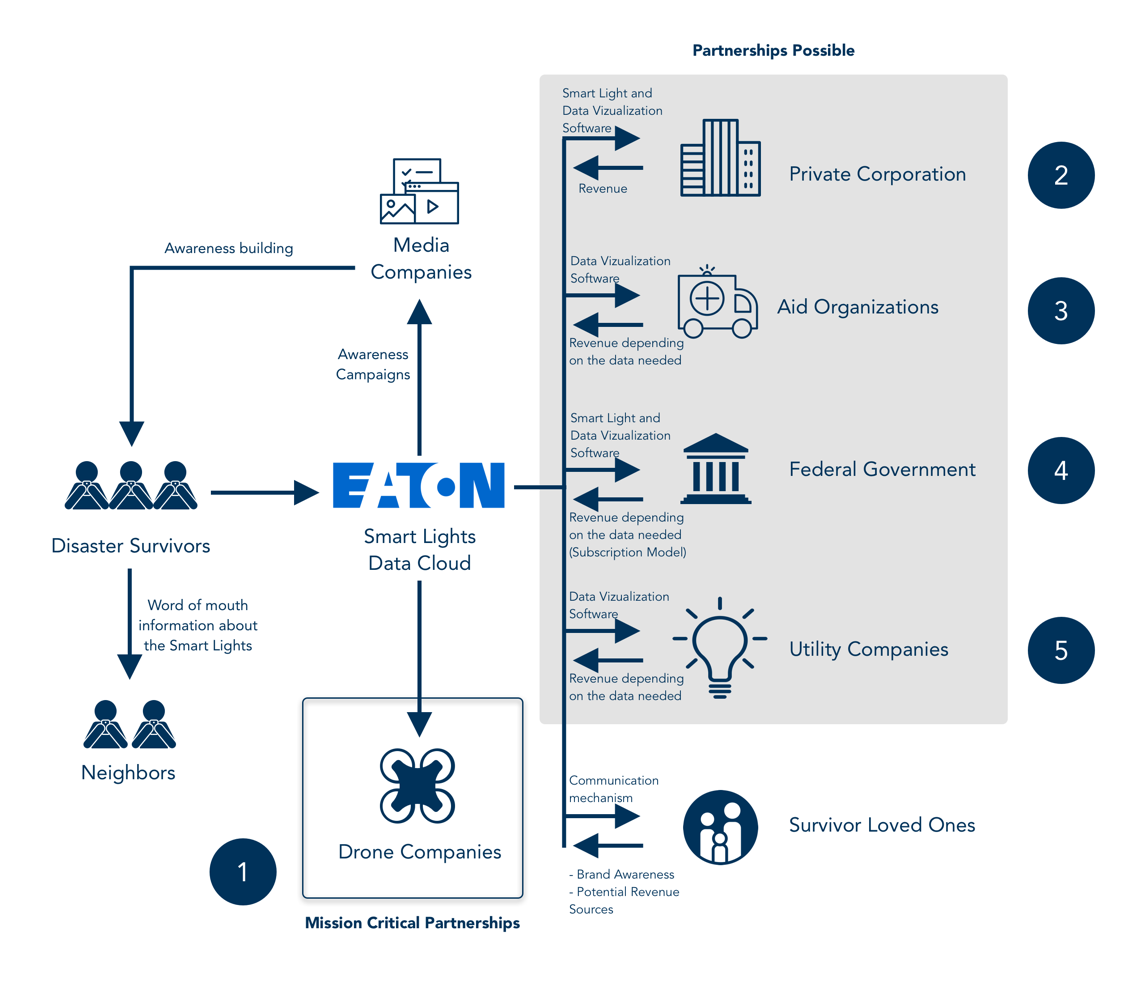Roadmap and Future Plans
Eaton asked us to imagine how ECN could work ten years down the road.
Overview
What does product and service implementation look like? We laid out a plan for Eaton to implement ECN over the course of the next ten years, in disaster-prone regions around the world.
Revenue Model
This document outlines how Eaton can establish partnerships and make money with ECN. This is important to ensure adequante funding and stakeholder buy-in.

Value Flow Between Stakeholders
Since this is a service model, there needs to be a co-creation of value with each of the stakeholders. Each one of these stakeholders helps us in a different way.
-
Drone Companies
The partnership with the drone companies is critical for the success of our service solution. We (Eaton) help them by not only creating brand awareness, but also creating new revenue streams for them. These revenue streams are in the form of the customized drones that need to be built to become a part of the mesh network, as well as the training program for the first responders. Apart from that, they can also help us by evaluating the area and determining the number of drones that will be needed to cover the area.
-
Private Corporations
Although private organizations may seem like an unusual stakeholder, we must establish partnerships with them as they will be the stakeholders who will invest in our hardware. They can install ECN hardware in various locations and by doing so, they have successfully managed to mark their location as a disaster resilient location. The feature in our first responder portal where you can determine whether a node is working or not can be used for maintainance optimization in their helping them manage their resources better. Our hardware solution can also be built onto other Eaton products that they might have invested in already.
-
Aid Organizations
Aid Organizations play an important role in building credibility and give us their previous data that helps us to create our initial estimation engine. Our first responder portal is mainly catered to their needs and with time, our estimations are going to get more accurate helping them plan better. Through data analytics that will take place, we can predict trends for the aid organizations to act on.
-
Federal Governments
These organizations help us in building credibility in our system. Along with that, we need them because they know about their area the most, and data provided by them will be accurate and reliable. In return, we can help them by giving them better infrastructure and the first responder portal which is powered with accurate, real time data. Federal governments can also make drills mandatory where early onboarding of the disaster survivors can be done and with the training program, the first responders can fly drones to the node locations.
-
Utility Companies
Utility companies can help us with the implementation of our hardware in public places and we can help them through the first responder portal software which will inform them about the status of the nodes. This will help them manage their resources better when it comes to regular maintenance checks.
Product Roadmap
The product roadmap envisions the future of ECN. This is divided into three main parts which talks about the future state of the hardware product, the software products, as well as the technological advancements that might happen in drone control. Along with this, we also explain internal partnerships that will be needed to make this solution a success.
1. Hardware Products

The indoor lighting department and the outdoor lighting department should collaborate to create a smart lighting solution that forms a mesh network.
Sensor development needs to start so that the entire mesh can now be automated. Furthermore, movement towards switching to solar energy should begin.
The indoor lighting department and the outdoor lighting department should collaborate to create a smart lighting solution that forms a mesh network.
Creating designs for drone nodes that have the capability of transferring data automatically.
2. Software Products

Design and development of all the three portals (survivor, first responder, and family) should begin.
If enough momentum is generated around this service, then early onboarding of users on the Survivor portal will allow them to set a password to protect their data.
The first responder portal can have a more accurate recommendation engine.
The family portal can have a search functionality which will allow them to search for their loved ones.
Creating designs for drone nodes that have the capability of transferring data automatically.
3. Drone Technology

Create a design for the development of the customized drones which can now become a part of the mesh network.
Create drone training programs for the first responders so that they are prepared when there is a need.
Implement swarm intelligence for drones. This will allow the drones to be controlled remotely with the help of artificial intelligence and will ensure that data can be collected frequently to find trends.
Focus on ways in which we can increase the payload capacity of the drones so that antennas that can be used to transfer information directly from it.
4. Internal Partnerships
For this service to be a success, the lighting department needs to collaborate with the R&D and the manufacturing departments. The R&D department also needs to work closely with the drone companies to create a node that can be mounted onto the drone.
The design departments should work with all the internal teams, as well as the data analytics team, which will be responsible for creating the estimation and the recommendation engines for the first responder portal.